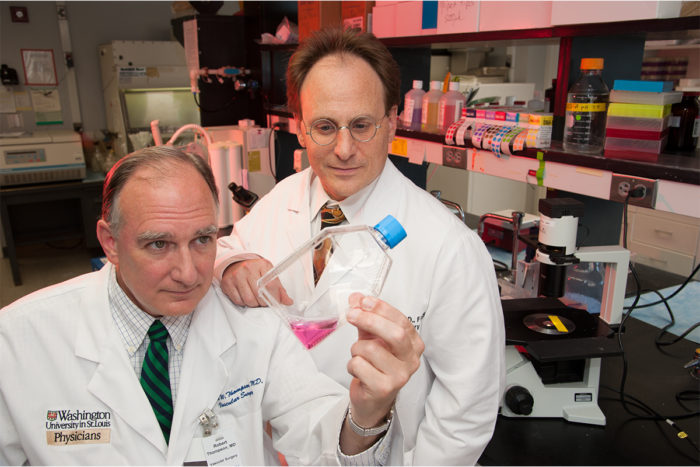Abdominal aortic aneurysms: New study tests medicine to prevent surgery
A national trial is evaluating an antibiotic as a non-surgical method to control the growth of aneurysms, or enlargements, of the abdominal aortic artery

Robert Thompson, MD and John Curci, MD are involved in a national trial to test whether an antibiotic could provide a non-surgical way to control the growth of abdominal aortic aneurysms.
Simple and elegant: Use a well-known generic drug to prevent the need for surgery and its risks. A national multicenter clinical study, N-TA3CT (Non-Invasive Treatment of Abdominal Aortic Aneurysm Clinical Trial), aims to do just that. It will test the use of a common antibiotic, doxycycline, against a placebo for stopping the growth of small abdominal aortic aneurysms, enlargements of the abdominal aortic artery. If successful, it has the potential of preventing or delaying the need for surgical repair, saving the patient and the health care system substantial risk, trauma and expense.
Two Washington University vascular surgeons at Barnes-Jewish Hospital play critical roles in the trial: John Curci, MD, is one of the principle investigators for the multicenter study; Robert Thompson, MD, will serve as the principle investigator for the Washington University site. Their basic research, conducted at Washington University since the 1990s, laid the groundwork for the trial. In fact, much of the knowledge that has been gained about the fundamental biological basis for aneurysms evolved from their work.
Building the evidence
“When we started in the lab, the idea of a drug that could prevent a problem thought to be mechanical in nature seemed far-fetched,” Thompson says. “Everyone believed that aneurysms were a degenerative process that would continue until it required surgical correction. Then we noticed that aneurysm tissue showed significant inflammation in the aortic wall. It became apparent that there was a biological problem, as well,” he says.
Basic research at other institutions suggested that this inflammation might come from enzymes called matrix metalloproteinases (MMPs), which are capable of breaking down structural proteins of the aortic wall. Curci and Thompson demonstrated that human aneurysm tissue carried high levels of one of the MMPs—MMP-9—and they developed a mouse model showing that mice without active MMP-9 do not develop aneurysms.
“That’s when we started looking at drugs with a known capacity to block those enzymes,” Thompson says.
The surgeons turned to the antibiotic doxycycline, which had been used for years to inhibit MMP-9’s contribution to gingivitis. They gave doxycycline to mice that carried MMP-9 and were able to block growth of the aneurysms.
Over ten years ago, Curci and Thompson first began using doxycycline in humans with aneurysms. They gave it for a week pre-operatively to 10 patients scheduled for aneurysm surgery, comparing this group to 10 controls who didn’t receive it. Then, after surgery, they measured MMP-9 in the removed aneurysm tissue and found MMP-9 was suppressed in the treated group. They later showed in a larger patient group that the drug was safe and well tolerated.
The N-TA3CT study
“Usually, when we hear about a potential new treatment for an illness, we’re thinking about a new drug that’s expensive and has unknown side effects. That’s not the case with doxycycline. It’s cheap and generic, and we know its few minor side effects,” says Curci. Thompson adds that those facts created a problem in acquiring funding, because there was no big money to be made. That’s a plus, they say. If the therapy proves as useful as they think from their past work, it will help control costs for treating the potentially catastrophic disease.
This study is among a relatively rare group of trials regarding a drug treatment to prevent surgery for a disease. Thompson and Curci expect to find even more effective drugs for the same purpose down the road, but for now, if drug therapy can help prevent or slow aneurysm growth, then patients who develop aneurysms in their 70s or 80s might never need surgical repair.
Participants in the N-TA3CT trial receive a computed tomography (CT) scan to check for aneurysm growth and a blood test to analyze drug levels, presence of various chemical markers and MMP-9 enzyme levels every six months of the two-year study. Curci is in charge of collecting the specimens from all patients and setting up a data bank so that specimens and data can be used by future researchers.
The researchers then assess which aneurysms grew enough to require surgery. “Small aneurysms are usually not a problem, but without intervention, most of them progress and eventually need surgery,” says Curci. “If we can keep them small by screening them with lower-cost ultrasound and treating them with an inexpensive drug, everyone wins.”







